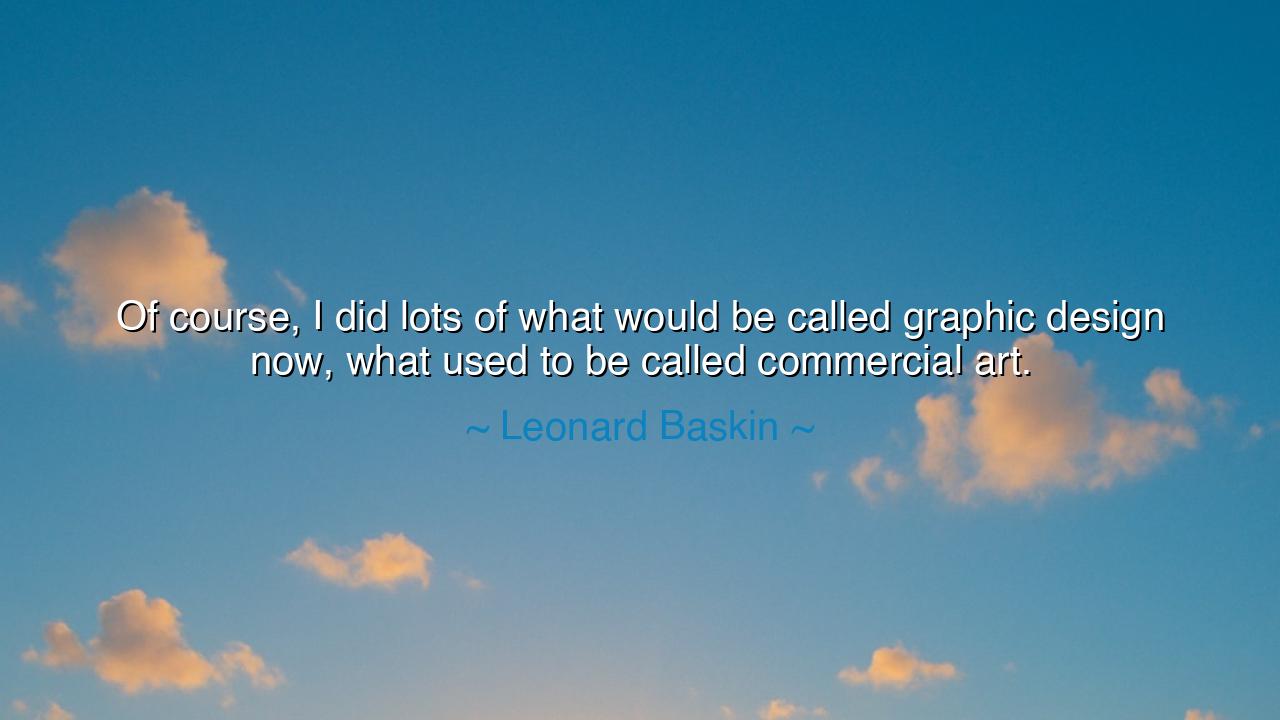
Of course, I did lots of what would be called graphic design now
Of course, I did lots of what would be called graphic design now, what used to be called commercial art.






The artist and printmaker Leonard Baskin, master of form and shadow, once reflected: “Of course, I did lots of what would be called graphic design now, what used to be called commercial art.” His words are simple, yet behind them lies the quiet wisdom of a creator who understood the eternal conversation between art and utility, between beauty and purpose. Baskin’s reflection reminds us that the boundaries humanity draws between “fine art” and “commercial work” are but illusions—fragile walls raised by those who forget that all art is born from the same longing to communicate, to shape the world with the hands of the soul.
In his time, the world of commercial art was often dismissed as lesser, as if purity of vision could not coexist with the demands of the marketplace. Yet Baskin, who crafted sculptures, illustrated books, and founded the Gehenna Press, knew that the artist’s task is not to separate heaven from earth but to join them. What some called “commercial,” he saw as craft—a sacred labor connecting thought to form, word to image. His art, whether etched in bronze or printed on paper, bore the same truth: that beauty does not diminish when it serves function; it deepens, for it becomes part of life itself.
The ancients knew this harmony well. In ancient Greece, the sculptor Phidias carved gods for temples, yet his work was also “commercial,” commissioned by patrons and bound to civic duty. In Japan, the artisans of Edo painted woodblock prints not for galleries but for the common people, to sell in markets, to bring joy to the streets. The world later named them “masters.” The divine and the practical were never enemies to them; they were two sides of the same coin, bound by the artist’s devotion to expression. Baskin’s words recall this ancient truth: that art loses its power not when it serves, but when it forgets to serve well.
When Baskin spoke of his “graphic design,” he was not boasting of adaptation but affirming a lineage—the lineage of those who carried artistry through changing tongues and times. What was once commercial art became graphic design; what was once ink and wood became pixels and light. Yet the spirit endures. The artist’s purpose remains unchanged: to shape symbols that move the human heart, to give form to the unseen. In this, every designer is a descendant of the calligrapher, every illustrator a companion to the ancient scribe. Names change, but the impulse remains eternal.
There is a lesson here for the proud and the doubtful alike. Many young creators disdain practical work, dreaming only of gallery walls and immortal fame. Others labor in studios and offices, believing their work too ordinary to be called art. But both err, for art is not measured by where it is shown, but by the spirit in which it is made. To design a poster with love, to craft a logo with integrity, to print a book with reverence—these acts are as holy as the chiseling of marble. Baskin’s quiet declaration restores dignity to the working artist, the one who shapes beauty not for prestige but for the shared fabric of life.
In his words lies also a reminder of humility. The artist does not create in isolation but in dialogue with the world. Every age renames its art, but the heart of creation endures. Baskin’s generation called it “commercial art”; ours calls it “design.” The next may find another name. What matters is not the title but the devotion, not the category but the connection between maker and humanity. Those who understand this find freedom: to create without shame, to serve without loss of dignity, to merge the sacred and the useful in a single act of creation.
Therefore, let the teaching be this: do not divide art by its labels, but unite it through its intention. Whether you paint, design, carve, or compose, do so with the fullness of your spirit. Every line drawn in sincerity becomes a prayer; every form shaped with care becomes a bridge between souls. As Leonard Baskin reminds us, greatness does not depend on what the world calls your art, but on whether your art calls something forth in the world. The hand that works for beauty—be it for coin or for glory—serves the same eternal muse. And that service, humble or grand, is one of the few gifts that endures beyond time.






AAdministratorAdministrator
Welcome, honored guests. Please leave a comment, we will respond soon